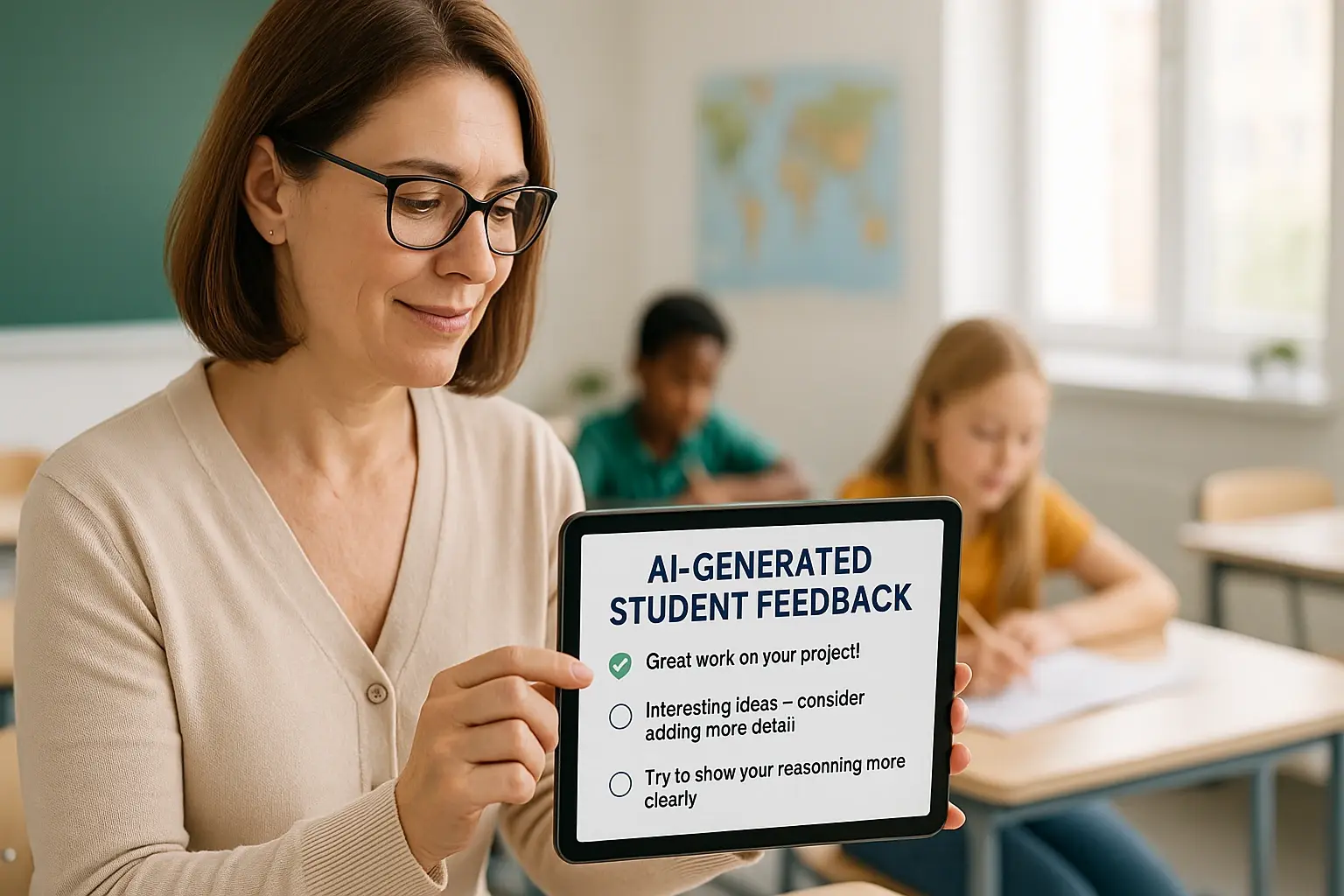When we say that AI is “transforming assessment and feedback,” we’re talking about how new technologies can help us evaluate students’ work more efficiently and give them better, more personalized comments and suggestions.
Think about how long it takes to mark dozens of tests or essays. Now imagine if a smart assistant could help you check those answers quickly and even give each student advice on how to improve. That’s the kind of change we’re seeing.
How AI Helps in Student Assessment
AI tools can do more than just correct spelling or grammar. They can:
- Understand what a student is trying to say.
- Compare answers to a model or ideal response.
- Point out specific areas where the student is doing well or struggling.
- Suggest next steps to improve learning.
Example: Grading Made Easier
Imagine a teacher named Carla. She has 35 students, each writing essays about climate change. Instead of spending hours reading every paper, Carla uses an AI tool. The tool highlights common mistakes, checks for plagiarism, and even suggests feedback like “Explain this point more clearly” or “Try adding an example.” Carla still reads the essays but spends less time grading and more time helping her students.
Real-Time Feedback: A Game Changer
Traditionally, students wait days—or even weeks—to get feedback. By then, they’ve moved on to another topic and may not even remember what they wrote.
AI changes that.
Instant Responses
Some platforms now offer instant feedback. Students type their answers, and the system immediately responds with comments or suggestions. This keeps students engaged and helps them learn faster because they can fix their mistakes right away.
Personalized Suggestions
AI doesn’t just give the same feedback to everyone. It learns from each student’s work and gives tips that fit their unique needs. For example:
- “You’re great at giving examples. Try working on organizing your ideas.”
- “Let’s review verb tenses in this paragraph.”
This kind of guidance builds confidence and helps students improve at their own pace.
More Than Just Tests: AI in Everyday Class Activities
AI isn’t only for formal tests. It can also help with:
- Daily exercises – Like quick reading or math tasks.
- Quizzes – That change based on the student’s level.
- Class discussions – AI can analyze what students are saying or writing in online chats and suggest new questions or ideas.
Example: Helping Shy Students
In an online class, João is too shy to speak up. But he types great comments in the chat. The AI notices this and suggests to the teacher: “João has strong ideas—try encouraging him to share more in group activities.” Without AI, João might go unnoticed.

Supporting Teachers, Not Replacing Them
Let’s be clear: AI is not here to take your job. It’s here to support you.
Teachers bring something to the classroom that no machine ever will—heart, understanding, creativity, and real human connection. AI is a tool that helps you do more of what you love: teaching, guiding, and inspiring.
Less Admin, More Connection
By handling the repetitive stuff—like correcting spelling, spotting patterns in student answers, or organizing grades—AI gives you more time to connect with your students.
You get to spend your energy where it really matters: listening, encouraging, and helping each student grow.
Challenges and Concerns
Of course, no tool is perfect. When using AI in education, we need to think about:
- Privacy: Who sees student data?
- Fairness: Is the AI giving everyone a fair chance?
- Access: Do all schools have the technology to use AI tools?
Teachers and schools must choose platforms that follow privacy laws like the FERPA and COPPA, which protect student data and online behavior. These laws ensure that children’s information is collected, stored, and used in a responsible and transparent way. Before adopting any AI tool, it’s essential to read its privacy policies and ensure it aligns with these regulations.
👉 Should schools be concerned about AI in education? Learn how AI can help or hurt and how schools can prepare wisely.
Key Benefits for Teachers
Here’s what AI can help you with:
- Save time on grading.
- Provide quick, personalized feedback.
- Identify student struggles early.
- Help with classroom planning.
- Keep students more engaged.
Key Points About Transforming Assessment and Feedback
- AI helps assess student work more efficiently and accurately.
- Teachers receive support, not replacement, from AI tools.
- Feedback becomes faster, more personal, and more useful.
- AI encourages student engagement and learning at their pace.
- Tools must respect privacy and be fair for all students.
- AI helps with both academic tasks and student behavior insights.
Conclusion
We know that assessment and feedback are essential parts of teaching. They guide students, highlight strengths, and show where improvement is needed. But they can also take up a lot of time and energy.
With the help of AI, this process becomes smoother, faster, and more focused on learning. Teachers can spend less time marking and more time connecting. Students can receive meaningful advice right when they need it.
By transforming assessment and feedback, AI offers a brighter, more personalized, and more efficient path for teaching and learning.
What do you think? Have you used any AI tools in your classroom? Share your experience in the comments—we’d love to hear your story!

